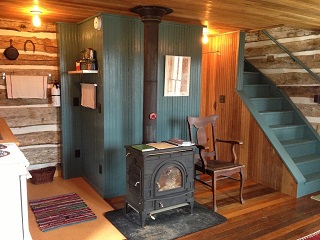From Guest Blogger Bobbi Peterson: How Your Wood-Burning Fireplace Is Harming the Environment

Wood-burning fireplaces, unfortunately, can also harm the environment and human health. Is it possible to have the benefits of a fireplace without the environmental downsides?
Impacts on the Environment
Wood fireplaces release a number of substances into the environment that degrade air quality. They don’t produce greenhouse gases the same way fossil fuels do, but they do create other pollutants.
All wood fireplaces produce microscopic particles called particulate matter, which can reduce air quality substantially in high concentrations. A woodstove that the EPA has certified releases around 97 pounds of fine particulate pollution per year, while an uncertified model produces as much as 244 pounds.
Burning wood also releases other natural pollutants such as nitrogen oxides and carbon monoxide, which is widely recognized as toxic. It also sends volatile organic compounds into the air, which react with nitrogen oxides to form ozone, a harmful kind of chemical smog.
Trees also absorb man-made toxins from their environment, which get released when the wood burns. These chemicals could include a wide range of substances, such as formaldehyde, benzene and benzo[a]pyrene.
Collecting firewood also requires cutting down trees, which absorb carbon dioxide and replace it with oxygen, provide important habitats and play crucial rules in their ecosystems. If proper forest management is practiced, the forest may actually be healthier than if left alone. Irresponsible use of forests, however, can cause severe environmental problems.
Sustainably heating a home for a year requires ten acres of trees. If 15 million people were to heat their homes with wood, they’d need to use one-fifth of America’s forests to do it. This means that sustainably using wood to heat homes is essentially not scalable to a large portion of the population.
Impacts on Human Health
Another issue preventing the widespread use of wood fireplaces is the health impacts of the pollutants they produce. In rural settings, they might not cause much of a problem. The denser population of urban areas, however, allows wood-burning pollutants to collect in higher concentrations, which can cause severe acute and chronic health problems. This has led cities around the world to ban them.
If you’ve ever sat around an open fire, you know that smoke can irritate your eyes, nose and throat. In cities where particulate matter collects, breathing the air can irritate the respiratory system and cause illnesses like bronchitis.
Long-term exposure to pollutants created by burning wood can lead to reduced lung function and chronic bronchitis. It might also increase the risk of cancer, but more research is needed on this subject.
Alternative Fireplace Options
Today, homeowners have various available alternatives to wood-burning fireplaces. They can be eco-friendlier, but all have their pros and cons.
As opposed to burning logs, some fireplace owners burn other wood products such as wood pellets. Wood pellets are made from lumber byproducts like sawdust. These pellets may burn cleaner than traditional logs and also keep those byproducts from ending up in a landfill.
Gas fireplaces are another popular fireplace option. They have relatively few emissions and release almost no particulate matter. They do, however, produce some greenhouse gases. You can fuel a gas fireplace with either piped-in natural gas or liquid propane. The latter option contains more carbon but burns hotter. The ability to retrofit a wood-burning fireplace with gas technology makes them a convenient alternative.
Another possibility is an electric fireplace. They are less realistic than a gas fireplace, but their design is improving. They are easy to use and usually just require you to plug them into an outlet. Their environmental impact depends on the fuel used to produce the electricity you use. If you get your power from solar, they will create no emissions. Energy generated by coal, however, releases high amounts of greenhouse amounts.
Thanks to the options available today, you can enjoy the warmth of a fireplace without the environmental harm that wood-burning fixtures cause.
